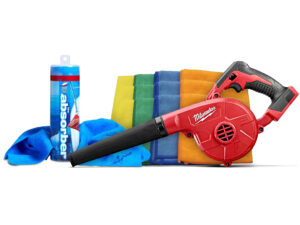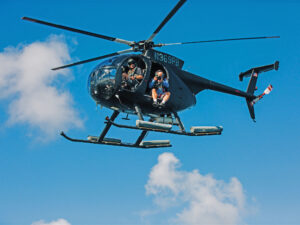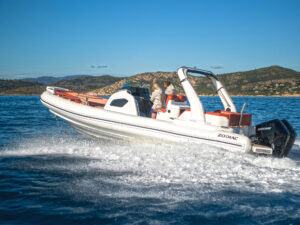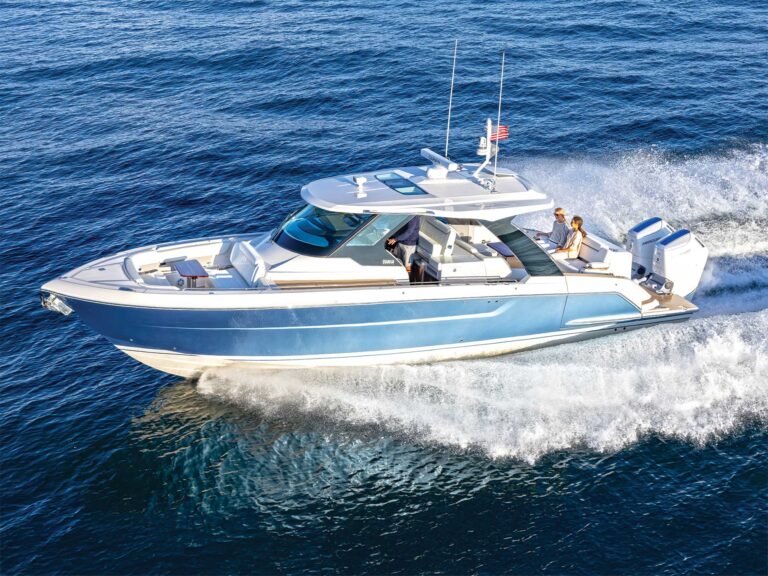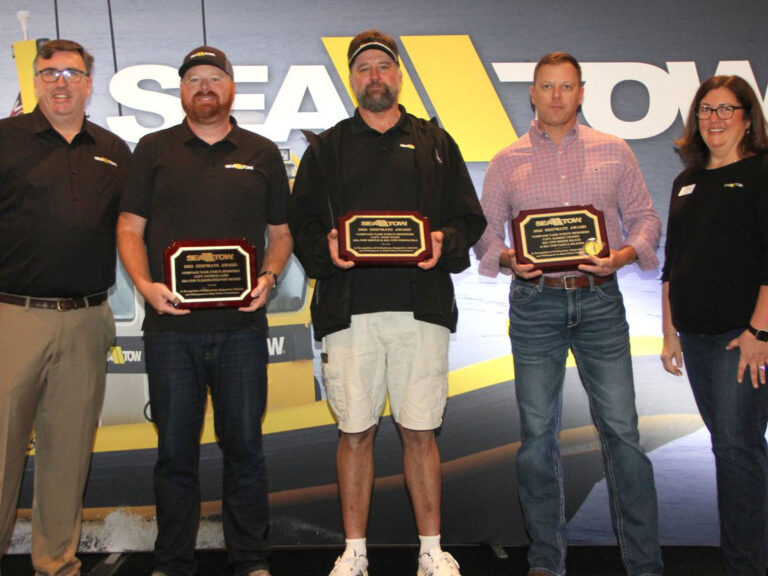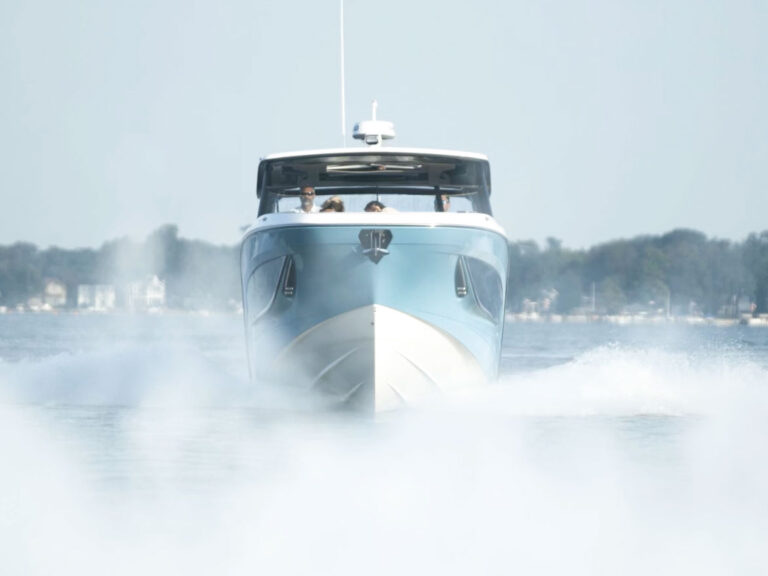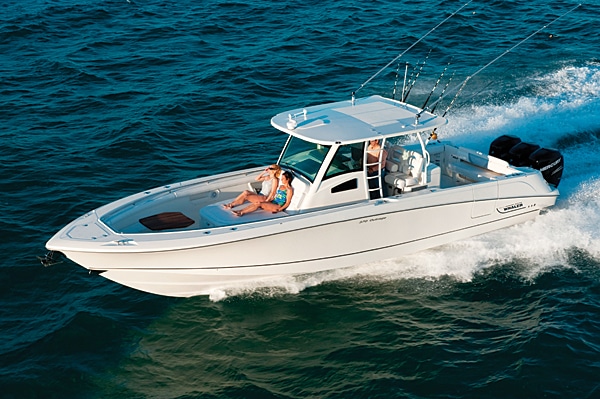
Boston Whaler 370 Outrage
Captains love it because it’s built like every other Whaler; it won’t sink. They also appreciate the portside dive door that opens inward, making it easier for guests to get on and off the yacht without climbing over gunwales. Boston Whaler
You’ve seen them on the interstate, giant buses turned into motor homes, land yachts really. And behind they’re usually towing a “dinghy.” Not a mini Kia either but a mega SUV so the King of the Highway can tool around town in style once he’s pulled into a KOA Campground for the night.
Well, real yachts do the same. Their tenders can be longer than 40 feet, weigh 12,000 pounds, pack more than 1,000 hp and, when towed behind, run the risk of ramming you, breaking loose or sinking.
This is the toughest duty for a boat. At the helm of the 100-footer, all seems smooth at 30 knots in five-foot seas. But out on the tow line, the tender, which is typically a boat in the size range that a 99-percenter can afford, is taking a beating. There’s no crew complaining to slow down and no captain aboard to throttle back. So the boats chosen as megayacht tenders must be built to the very highest standards. Only a select few make the grade. This story explores why that’s so, and how the world’s toughest small boats survive as yacht tenders.
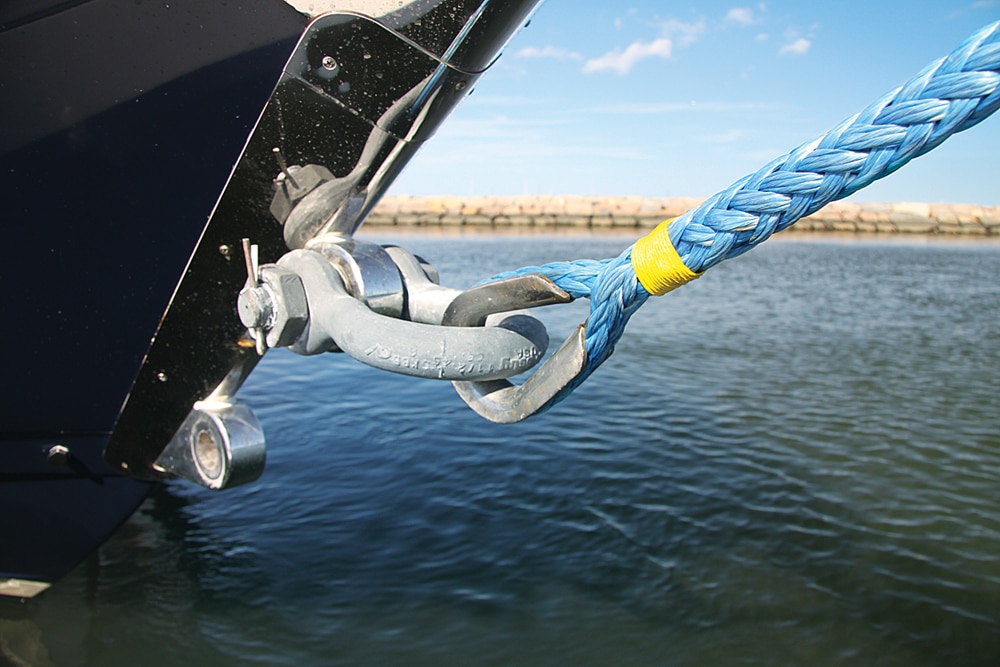
Toughest Tenders
Nose Jobs
Forget the puny bow eye used for trailering your boat. Big tenders use serious hardware. Typically there are two eyes, stacked one above the other. Each has a heavy 316 stainless-steel external mounting band bolted to a matching internal 1½-inch-thick backing plate. Builders hide the band under layers of glass, while aftermarket installations show it off like a big steel grin. The big name in this specialized field is Broward Machine (browardmachine.com) of Dania, Florida, which works with builders and owners.
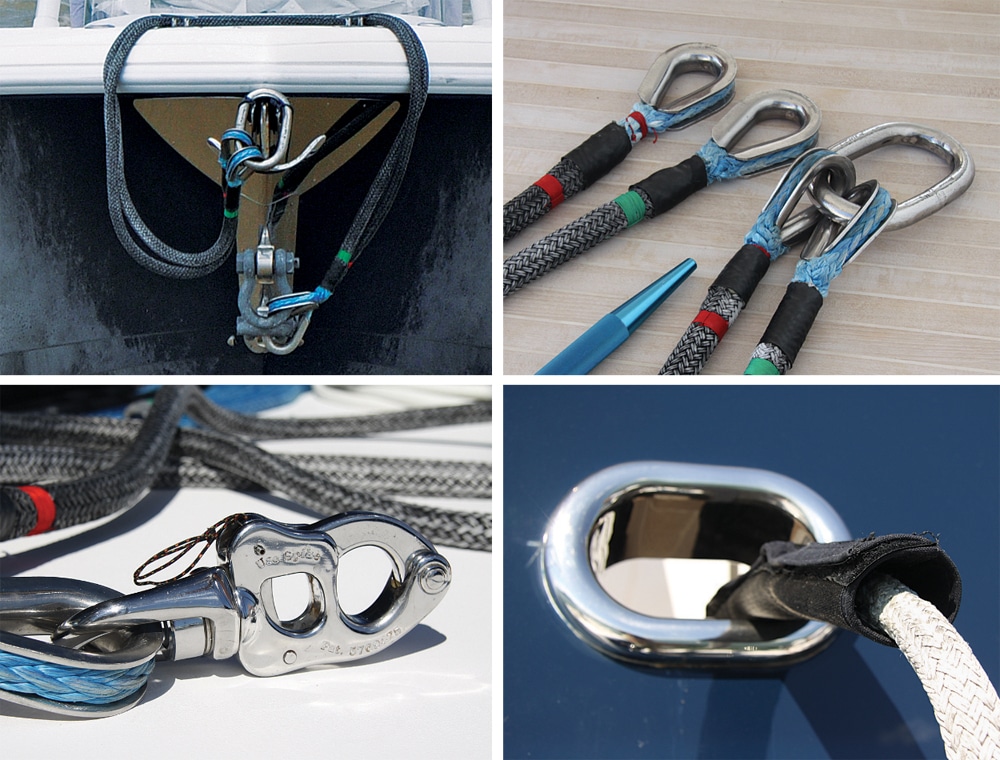
Toughest Tenders
Custom-made and purpose-built: the keys to the tow line. Boating Magazine
Pull Toys
Forbes magazine used to publish an annual list of millionaires. How quaint. Now the “m” has been replaced by a “b,” as in billionaires. As the money grows, so does the size of the boats that these Masters of the Universe buy. And as the yachts get bigger, so do their tenders. It’s that old saying, “One man’s big boat is another’s dinghy.” It’s all part of an elite world where boats like ours are being towed behind what are, in effect, small ships.
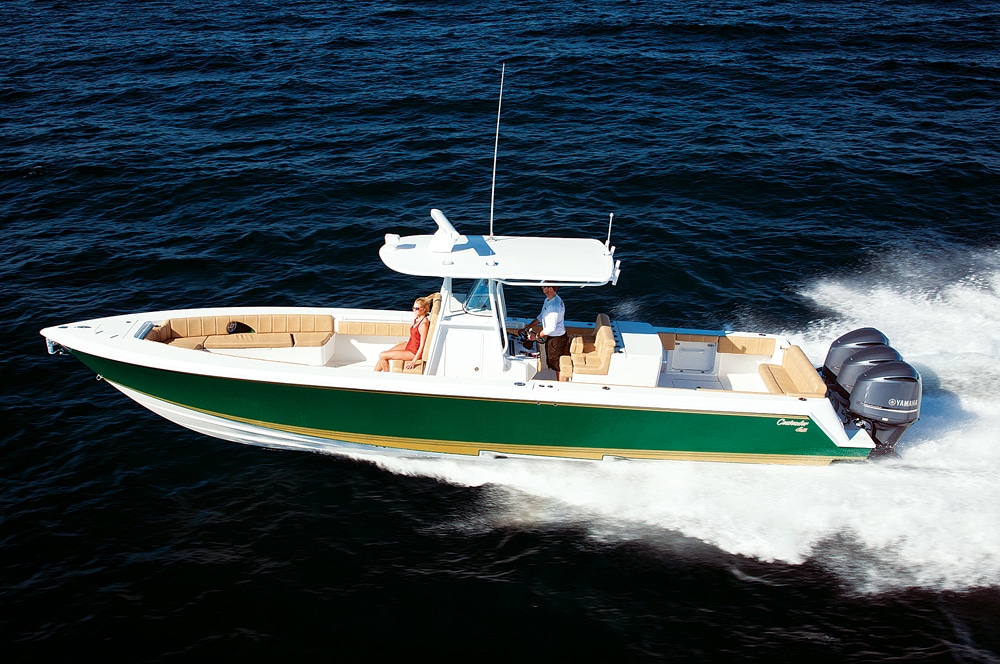
Contender 39 Luxury Sport
The manufacturer has begun with this tournament-level fish boat and gentrified it with features that nonangling yacht guests will want, such as a full entertainment center, tables fore and aft, and reclining lounges. The hull can be stepped or straight-V. Bill Doster
As Capt. Rob Loveall of the 117-foot Annastar tells it, “We come into St. Barts and we’re lost in a fleet of 200-footers, and they can be towing full-size-cabin sport-fishing boats.” Not to be left out, the Annastar recently supersized from an Intrepid 370 center-console to Intrepid’s 400 model.
Loveall, who is 44, says he first noticed the trend when he started out in the mid-1980s. “Back then it was a rare sight,” he remembers, “but it caught on fast, and the boats and gear grew with it.”
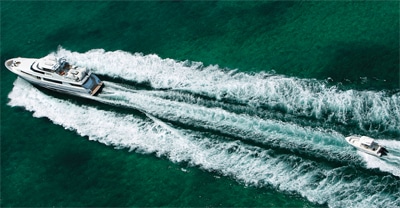
Still, the most common yacht tender is a 24-foot RIB, which does the work of hauling guests and gear. The big boys at the end of the tow lines are there, as one captain told me, to flaunt it. Typically these boats are center-consoles for fishing, but they must also provide a level of comfort and luxury in keeping with the mothership.
With the indulgence of big tenders comes big problems. Loveall says that towing can be a challenge in the best of times, and often downright dangerous. He’s had boats veer off wildly or charge at the yacht, only to come up short on the tether to be whipped back in place with frightening force. “Sometimes in big seas we’d lose sight of the boat for days, hidden by waves,” he says with a shaking head. “The only clue it’s there is the almost constant strain on the aft cleats.”
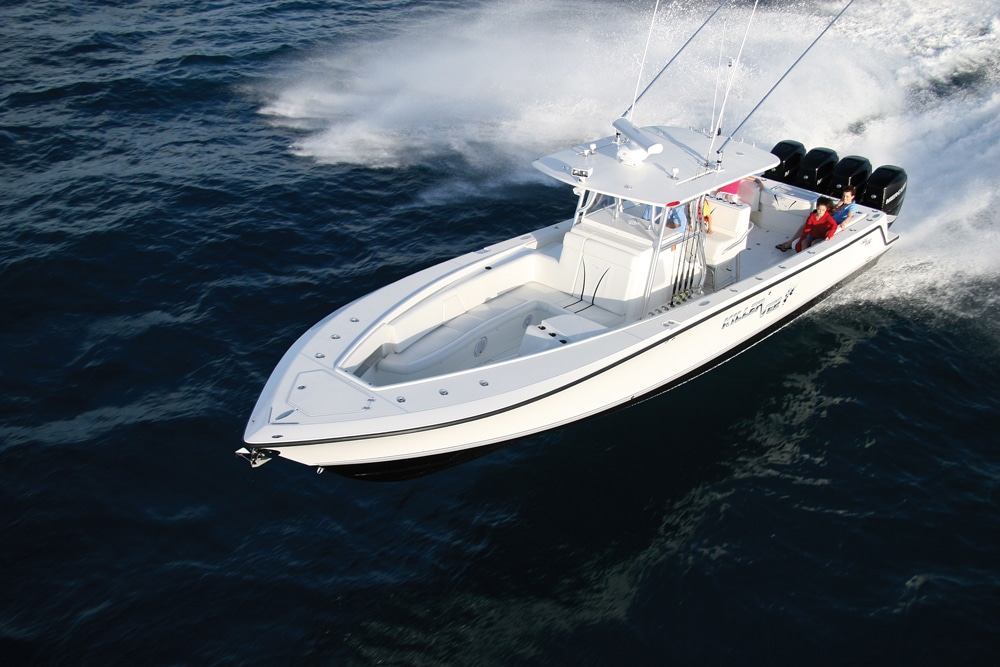
SeaVee 390 Luxury Edition
This is a center-console that looks fishy but is the perfect multitasking yacht tender for entertaining, shuttling guests or using as a support boat. There’s plenty of room and seating with its 11-foot beam. Its deep-V hull and low center of gravity mean it tows well too. SeaVee Boats
Over the years he has ripped out bow eyes, had lines viciously snap back at him, and let loose the smaller boat to save the larger. To keep all of this drama to a minimum, it’s all about the gear, experience and training.
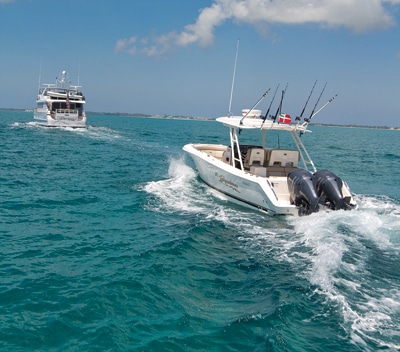
Follow Me
“See that coil of line?” Loveall asks. “That’s $8,000 worth of the best rope there is.” Not only is it made from the finest line, but it’s also put together in a way that has taken decades of failures to figure out. Right now, the go-to guys for making up a towing rig like this are at Rope Inc. (ropeinc.com) in Fort Lauderdale, Florida. They made the one for Annastar, and while there are many variations, this is a good example.
Starting from the yacht’s stern there is a bridle with 60-foot legs made of 1½-inch braided, highly elastic nylon to absorb the thousands of pounds of shock. The two ends that come back to Annastar are spliced into lines made of Spectra for about four feet and then formed into eyes large enough to fit over the yacht’s massive aft cleats. Spectra is 10 times stronger than steel, has zero stretch and is soft and pliable so it’s easy to handle, plus it floats — so it is less likely to get fouled in a prop.
To prevent chafe where the bridle touches the deck and passes through the hawsepipes, there is protection from a sheath of Spectra, covered with an additional layer of Kevlar, the stuff they make bulletproof vests of. This might seem like overkill, but chafe is a major factor in tow-line failure, and Loveall says he has seen line wear out after only 10 hours.
Each leg of the bridle and the 120-foot main hawser of one-inch Spectra are eye-spliced together. Each eye has a Spectra sleeve covered by nylon to — once again — reduce chafe. On the tender’s end of the hawser is a Tylaska T30 snap shackle that’s critical if a quick release is needed, but at the same time it’s the rig’s weakest link. Not that it’s engineered or made poorly. It looks tough as hell, is big enough to hold in two hands, is rated for a 50,000-pound working load and costs $3,000. So you have to believe (and pray) that it’s up to the job with no possibility of jamming.
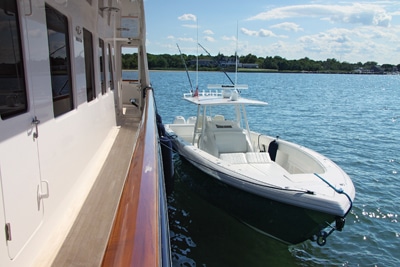
The snap shackle clips onto a stainless-steel eye that has two Spectra lines eye-spliced onto it. These lines are the tender’s pendant, making the final short run to the two massive bow eyes. The lines have spliced eyes with stainless-steel thimbles that are connected to the bow eyes with 1½-inch shackles. The pendant stays on the tender, draped over the anchor chock when not in use.
“Over the years I’ve broken almost every fitting,” Loveall admits, “but we don’t break anything anymore.” Hard-won lessons: ones that have led him to an improvement of his own that even we small-boat owners can use. He makes up hard, low-friction, plastic Delrin shim washers to keep the shackle pins from sliding back and forth, which can enlarge the holes they pass through, allowing the pins to bend and fail.
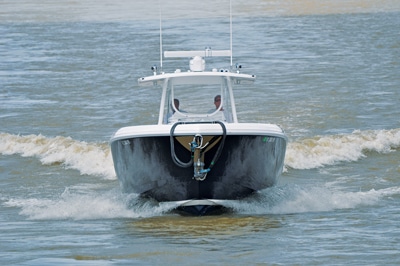
Dancing Lessons
One captain I spoke with said that he had just towed 700 miles in 30-knot winds and eight-foot seas with no problems. “We got lucky,” he said. “It’s not if something will go wrong, but when.” Loveall agrees, which is why Annastar carries specialized towing insurance. Even so, he says, that the policy covers only 50 percent of the boat’s value during the day and none at night, which gives you an idea of the serious risks involved.
To put the odds in their favor, captains prepare for the worst. Most center the boat’s engines with the drives down to provide additional directional stability. Some drag a line behind to help hold the boat straight and to serve as a handhold if a crew has to swim for a tender that has broken free. Fuel tanks are kept full, the keys left on board, hatches and gates secured, water and food stowed, and foul weather gear kept ready in case a crew member has to run the boat offshore. They check bilge pumps but don’t depend on them, because batteries can lose power. It’s best if the tender has large-capacity freeing ports and scuppers and is watertight and self-bailing. And, of course, the yacht carries a sharp axe capable of quickly cutting the tow line.
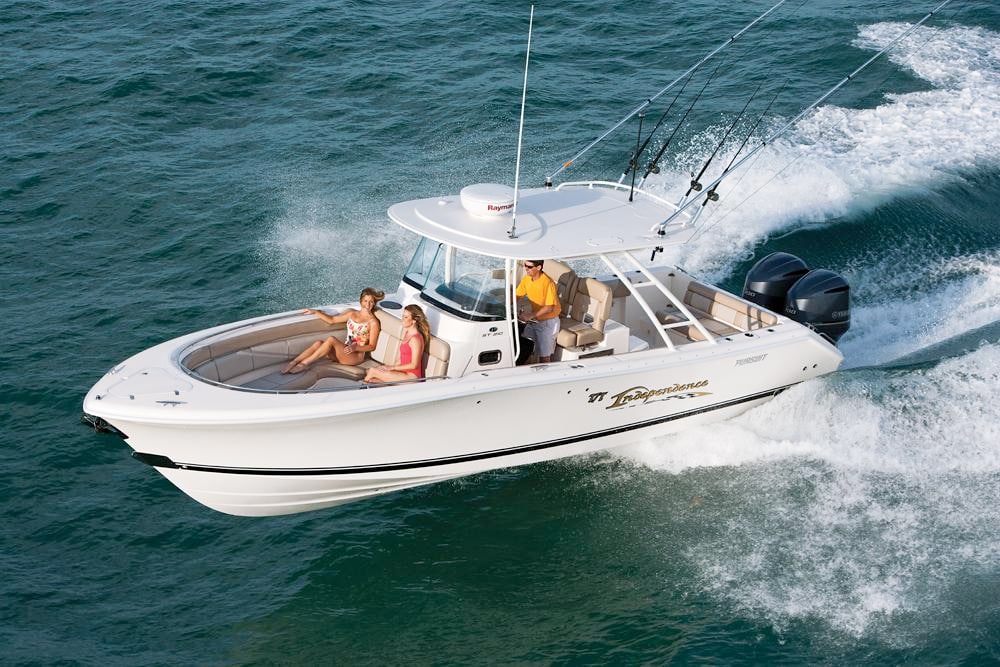
Pursuit Sport Tender 310
The ST 310 is a dedicated model for yacht service featuring heavier laminates, extra reinforcements, high-capacity bilge pumps with an alarm, separate electrical system for towing lights, larger deck drains, bigger cleats, thick vinyl rub rail and more. Bill Doster
Since one boat is towing another, the correct navigational lights must be shown as specified in the International Regulations for Preventing Collisions at Sea (Colregs) Part C, Rule 24. The lights on the tender should have their own dedicated battery, with solar recharging/backup, so as not to drain the main starting bank. Many captains place a radar reflector on the tender so it shows up on a passing ship’s radar as a tug-and-tow and makes it easier for the captain to monitor the boat on his own radar.
The tow starts with the tender lashed “on the hip,” sitting on the yacht’s quarter, for better control while in confined waters. The tow line is attached and the boat cast free once in open water. To retrieve the boat the yacht is kept moving ahead at dead slow while the crew manually pulls the tender in. The captain never backs up the yacht to get the boat since that increases the possibility of a fouled prop.

In good weather Loveall tows fast; many captains run up to 25 knots. “We found that once the tender gets on plane there is less drag,” he tells me. “We only lose about 1 knot from our cruising speed.” He adjusts the hawser length to fit the conditions, with the tender usually sitting on the back of the wake’s third wave, riding bow up. When headed downwind, he slows down, letting the boat drag a bit to keep it from overrunning the yacht.
Towing a big boat is tricky and potentially dangerous. One cautious captain said he prefers to ship the tender rather than take it on long passages. “We avoid the risk of bad weather and losing the boat,” he says, “and I get a better night’s sleep.”

